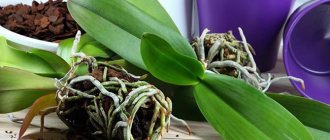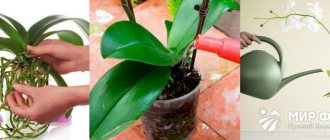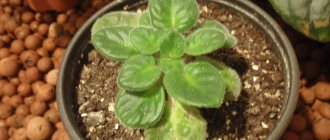The tropical beauty orchid has long settled in Russian apartments.
In general, this flower can hardly be called capricious to care for. But sometimes the orchid shows its southern character and refuses to bloom. Dear readers!
For you, we have created communities on social networks in which useful articles and interesting ideas are published several times a day! Subscribe and receive useful content in a convenient format! In today's article we will look at the reasons why an orchid does not bloom, and also look at various ways to stimulate the flowering of this plant.
Before we start stimulating flowering, let’s figure out what conditions an orchid needs to produce a peduncle.
Requirements for the conditions of keeping an orchid for the appearance of an arrow:
- A large amount of diffused light. Your green pet should receive at least 12 hours of sunlight per day. Otherwise, the peduncle will freeze and will not release a bud.
- Comfortable temperature. During the day, the orchid needs to maintain the temperature at +25 degrees. At night the temperature should be at least 5 degrees lower. If you do not achieve a difference between night and day temperatures, the peduncle may freeze in development.
- Regular watering as the soil dries out. A competent watering regime is the best way to force the arrow to release.
- High humidity levels. Also, do not forget to spray the flower from time to time.
- Proper diet. An orchid needs potassium and phosphorus to bloom. And the best option is special fertilizers for orchids. These, for example, are produced by the Agricola company.
Why does an orchid refuse to bloom?
So, you have provided the orchid with all the necessary growing conditions, you are caring for it in accordance with the rules, but there is still no flowering. This may be the case.
The absence of a peduncle is due to a violation of the conditions of keeping and caring for the flower.
Lack of lighting and irregular watering with cold water lead to no flowering.
In addition, the absence of flower stalks is affected by incorrectly selected temperature conditions, as well as the application of the wrong type of fertilizer or the absence of any fertilizing at all.
ON A NOTE. A cramped or too spacious pot and uncomfortable humidity also affect the growing season of the orchid.
Reasons for lack of flowering
It often happens that a houseplant does not bloom for years. The reason may be a lack of light or the wrong temperature. If a flower is disturbed in its dormant mode, this will negatively affect its flowering. The reason for this undesirable phenomenon is improper watering. In most cases, it consists of frequent waterlogging of the substrate.
In most cases, an orchid stops blooming due to lack of lighting. To solve problems with flowering in this case, you just need to provide the indoor plant with light. It must be remembered that excess light can also negatively affect the growth and development of the plant. The sufficiency of light can be determined by the condition of the orchid leaves. If they are characterized by a light green tint, this indicates sufficient light. If a yellowish tint appears on them, it is necessary to reduce the amount of light. If the grower notices that the new leaves have a more saturated green color, then this indicates a lack of light.
To ensure the flowering of an orchid, it is necessary to care not only for the above-ground part of the plant, but also for the underground part of the plant. It is quite difficult for gardeners to identify problems with the root system, but careful observation of the flower makes this possible. Immediately after the roots of the plant rot, it is impossible to see this by external signs. In most cases, rotting of the plant's root system is observed due to improper watering. That is why it is better to grow an orchid with a slight moisture deficit than with an excess of it.
There are several reasons for the lack of orchid flowering. If they are eliminated, the gardener will be able to enjoy the beautiful flowering of the indoor plant in the shortest possible time.
When do orchids usually bloom (time)
Each plant has its own life cycle. The implication is that the flowering and dormant periods occur at approximately the same time. Orchid in this case is no exception.
Despite the fact that the flower grows at home, it still follows the vegetation mechanism laid down by nature.
Orchid blooms in autumn. At this time, in nature there are strong fluctuations between day and night temperatures (up to 10 degrees, from 15 to 25).
On average, a peduncle is formed within 60-90 days, but this period can be significantly accelerated if proper conditions are created.
Which fertilizer is better to choose?
The choice of optimal feeding primarily depends on the conditions in which the orchid is grown and the time cycle in which the plant is located. It is worth refraining from mineralizing the soil of the orchid during its wintering (resting state), illness or rooting period.
In order for an orchid to bloom, it requires certain trace elements and mineral supplements. The growth and flowering of a healthy orchid is impossible without mineral supplements based on nitrogen, phosphorus and potassium. These are the three pillars directly involved in the flowering process.
The percentage composition of any mineral fertilizer is always indicated on the packaging, and all the necessary elements are usually collected in proportions that will provide the plant with a favorable peduncle.
How to water orchids to bloom
Watering is the main agrotechnical activity when caring for plants. Proper hydration will help bring flowering closer.
You need to water the flower with warm, settled water. You need to pour water carefully so as not to flood the outlet.
In general, watering an orchid should imitate the weather in the tropics. Therefore, sometimes it is useful to take a warm shower. But there is no need to be too zealous, since abundant watering does not encourage the orchid to release a peduncle.
If the arrow stubbornly does not want to appear, then watering should be reduced, or even stopped altogether for a while. After the appearance of the peduncle, watering is restored gradually. There is no need to pour a lot of water at once.
What liquid fertilizers do orchids need?
When choosing fertilizers for an orchid so that it blooms quickly, you should give preference to liquid formulations. The fact is that nutrients in liquid form are better absorbed by the plant.
In addition, phalaenopsis growing at home does not tolerate fertilizers in any other form. Therefore, even if you bought drugs in a different form factor, they still need to be dissolved in water.
For orchids, it is allowed to use both specialized fertilizers and universal mixtures. But there is a rule. When using universal mixtures, their concentration is reduced by at least half.
IMPORTANT! Before applying fertilizer, soak the roots of the phalaenopsis in warm, settled water.
What fertilizing is needed for an orchid to produce a peduncle?
No less important is the issue of orchid nutrition. If the fertilizing is chosen incorrectly, then flowering may not occur. The orchid, instead of releasing a peduncle, will direct all its forces to the formation of leaves or roots.
You can avoid this and make a flower stalk appear by organizing proper nutrition. The plant must be fed with a mixture of potassium and phosphorus fertilizers.
And the best option would be to use liquid complex formulations designed specifically for orchids.
Feeding should be carried out at intervals of 1-2 times a month. Moreover, the application of fertilizer must be completed before flowering begins.
And be careful not to use products containing nitrogen. It causes an increase in green mass and inhibits flowering.
The influence of plant care on its health and development
Excessive zeal in care is just as destructive as negligence. Both can lead to :
- Refusal of the plant to flower;
- And sometimes even to death.
To prevent the orchid from dying, it needs proper care.
It is important to create conditions close to the climate of the region where the species naturally grows. Take into account and recreate periods of intense vegetation and dormancy. Remember that most orchids are epiphytes and lithophytes, this determines the requirements for:
- Substrate;
- Lighting;
- And ventilation.
If you follow the rules of care, the orchid will not only grow well for many years, but will also regularly delight you with exquisite inflorescences.
Let's consider the determining factors for life and flowering.
Features of watering
During the active growing season and at the beginning of flowering, water the plant abundantly , but do not allow prolonged accumulation of moisture at the roots. Take warm, settled water.
The frequency depends on the microclimate of the room and the needs of the plant. As a rule, 2, rarely 3 times a week is enough. Monitor the condition of the roots and substrate. They should dry out slightly before the next watering.
Spraying and humidifying the air using artificial humidifiers and a simple container of water located next to the plant are useful
Attention! After flowering ends, watering is reduced. During this period, new flower buds are formed.
Lighting
During the flowering season, the orchid needs 13–14 hours of daylight. In winter, lighting is required . Special phytolamps are suitable for this, but you can try to add additional light using a regular energy-saving light bulb.
Lighting throughout the life of the plant should be intense , but for most species it should be diffused. Successful placement - eastern, western window sills. Phalaenopsis also feels great in the northwestern region.
Lack of light is fraught with :
- Stopping development;
- Stopping growth.
If there is insufficient lighting, the orchid may stop developing.
Excess is fraught:
- Lush growth of greenery;
- Refusal to bloom.
In addition, direct rays of the sun are dangerous :
- Overheating;
- And leaf burn.
Top dressing
With the exception of the dormant period, the orchid needs to be fed . Do this 2-3 times a month. Early growth requires more nitrogen. During the formation of flowering stems and buds, the composition of fertilizers is changed to potassium and phosphorus.
Apply by root method , giving simultaneously with watering and by spraying the leaves. To do this, use ready-made complexes purchased in specialized stores, or prepare them yourself, following the recommendations.
Attention! The concentration of mineral fertilizers for orchids should be two times less than for other indoor plants.
For foliar feeding, the concentration is also reduced by half compared to root feeding.
How to make an orchid bloom: step-by-step instructions
Now let’s look at a step-by-step algorithm for making a plant produce a peduncle.
ON A NOTE. All of the listed agrotechnical measures are carried out strictly within the framework of shock therapy. They cannot be kept in such conditions permanently.
Step 1. Provide an artificial temperature difference. To do this, we move the pot to where there will be a difference in night and day temperatures of 7 degrees. For example, a glazed balcony or a north window.
But check that there is no draft.
Step 2. Artificially shade the flower. At this stage, you need to change the lighting mode to “shock” your green pet.
Step 3. For 10-20 days, we completely stop watering or change the moisture regime. For example, instead of watering once a week, water once every 2 weeks.
IMPORTANT! Don't do all the steps at once. Carry out only one method of “shock therapy”. If one does not work, then let the plant gain strength and move on to the next one.
Another fairly effective algorithm to make a plant bloom.
Step 1: Stop adding water for 10-15 days.
Step 2. Move the pot to a dark closet.
Step 3. After a week, provide abundant watering and fertilizing with liquid potassium-phosphorus fertilizer.
Step 4. Move it to a windowsill or balcony where there will be a temperature difference.
The peduncle will appear after 15-20 days.
Basic prerequisites for abundant flowering
Orchids bloom for 3 months, and some specimens, depending on the species, can last up to 8 months. The following factors influence the abundant flowering of an orchid :
- As soon as all the buds open, the flower is moved to partial shade. In this case, the sun's rays will be unnecessary;
- Maintain a cool temperature from 17 degrees C to 22;
Several factors influence the abundant flowering of an orchid. - Eliminate fertilizer completely until the end of flowering. Any fertilizing will cause premature wilting of flower clusters;
- Watering should be done once every three days, immersing the pot with warm water for 10 minutes. You should focus on humidity; at low humidity this may happen more often, at high humidity less often. Whitened roots also serve as a signal;
- Spray periodically using a spray bottle.
Important! If you follow the recommendations, the plant will reward you with long flowering.
How to get multiple arrows
In some cases, you can get several arrows on one copy at once.
Firstly, to do this you must adhere to all the rules for caring for orchids.
Secondly, as soon as flowering ends, cut off the dried old flower stalks to the top bud. Treat the cut area.
A new arrow will appear from it, and another one, as usual, from the leaf sinus.
As a result, you will have an orchid with 2 peduncles.
REFERENCE. Don't be upset if you did everything according to the instructions, but only got one peduncle. The number of shoots depends on many factors. Including, from genetics, the age of a particular specimen, the condition of the roots, etc.
How to make an orchid's arrow grow upward
Those specimens whose peduncles grow vertically have a special charm. This indicates the high skill of the florist.
Here are some recommendations on how to make the peduncle grow upward, and not sideways.
As soon as the arrow grows to 20 cm, fix it with a stand in a vertical position.
At first, the peduncle is green and flexible, but you still need to carry out the procedure very carefully so as not to break the arrow.
As it grows, continue to fix the peduncle on the support.
Use wide string or tape to avoid damaging stems and shoots.
In addition, keep in mind that in natural conditions, flower stalks grow horizontally. Therefore, turn the orchid pot from time to time. The arrow will reach towards the sun, and this way you will make it grow vertically upward all the time.
What stimulants can be used
Sometimes it happens that just agrotechnical measures are not enough for flowering. In this case, it is necessary to use stimulants.
Succinic acid is an effective stimulant. For 1 liter of water you need 4 tablets of the drug.
To stimulate flowering, the pot is placed in a prepared succinic acid solution overnight. This procedure is carried out regularly every 7 days.
You can also use cytokinin paste to force the flower to produce a peduncle.
But experienced flower growers advise not to get carried away with stimulants. Succinic acid will be quite enough.
The fact is that stimulants weaken the orchid. She spends all her energy on flowering. This undermines her immunity, and she becomes easily vulnerable to diseases and pests.
You can use both store-bought drugs and products prepared according to folk recipes.
ON A NOTE. Store-bought stimulants are much more effective, since they contain a higher concentration of the main active ingredient.
Stimulation of peduncle formation in phalaenopsis
The lack of flowering in phalaenopsis can be expressed in different ways. The most common manifestation is the plant’s persistent refusal to release a peduncle. At the same time, phalaenopsis can feel great, regularly produce new leaves, and branch the root system. For 1-3 months this is normal, but sometimes this situation drags on for a year or more.
If phalaenopsis does not release an arrow for a long time, you can force it to change the phase of its life cycle as follows:
- Artificial drought. First, over the course of a month, watering of the orchid is gradually reduced. During this period, bathing in the shower and immersing the pot in water stop, irrigation becomes rare and only through a watering can along the edge of the pot. After a month, watering and spraying are completely stopped. The dry period can last from 3 weeks to a month.
- Decrease in temperature. This measure enhances the effect of artificial drought. While drying, the orchid is placed in cooler conditions than usual, and after the end of the dry period it is returned to its place.
This type of stimulation is called “stress” and is successfully practiced by many gardeners:
“In general, my phalaenopsis blooms regularly. But there was one stubborn person who, after the end of the store flowering, sat idle for a whole year. I felt sorry for him for a long time, but in the spring I decided to stress him out. I dried the soil, sent it to a glassed-in balcony and left it there without watering for almost a month. During the day the temperature there was normal, about +250, but at night it dropped to +10. There is a lot of light. When the leaves began to wrinkle slightly, I returned the exile home, watered it by immersion and fed it. The arrow hatched after 2 weeks” (Alla, Podolsk).
Once the peduncle begins to grow, irrigation must be done regularly. At this stage, you should not allow the substrate to dry out for a long time, but it is also not recommended to fill it. The soil should saturate the roots with water and dry out within a few hours. The next watering is 2-3 days after the velamen layer has whitened.
Why does the shoot freeze and not grow?
The freezing of the escape is associated with a violation of the conditions of detention:
- lack of sunlight;
- there is no difference between day and night temperatures;
- improper watering;
- too dry air in the room, lack of spraying or improper spraying;
- lack of potassium and phosphorus in the diet.
IMPORTANT! A combination of factors usually leads to the fading of a peduncle, but the harmful effects of any one of them cannot be ruled out.
Common mistakes
Let's look at the most common mistakes that gardeners make when they try to encourage an orchid to produce a peduncle.
- The frequency and abundance of watering increases. Before flowering, the amount of water must be reduced, or even stopped altogether. Such stress will cause the orchid to release a flower stalk.
- No temperature changes. The difference between day and night temperatures should be at least 5-7 degrees. Only then will the orchid throw out an arrow on which buds will subsequently appear.
- Abundant feeding. There is no need to overfeed the flower. 2 feedings per month before the period of active flowering are enough. And these fertilizers must be potassium-phosphorus. And ideally, it is necessary to use liquid complex formulations.
- Use of strong growth stimulants. A healthy orchid will bloom without stimulants. But their uncontrolled use can only harm your green pet.
Orchid blossom
Stimulations
If, after a long rest, a healthy, well-developed orchid does not form flower stalks, you can slightly “push” it . To do this, you can create mild stress for the capricious person and take her out of a state of comfort.
Temperature difference
Well-proven methods associated with temperature differences :
- Decrease or increase the usual temperature by 7-8 degrees for 1-2 weeks;
- Ensuring daily changes of 4–5 degrees (colder at night than during the day).
Use of stimulants
You can use special stimulants offered by florist companies.
An orchid can be stimulated with special means.
Experienced orchid growers consider this method risky, because excessive stimulation can lead to:
- Rapid depletion of the plant;
- And shortening its lifespan.
Limiting watering
Among the stresses that can cause an orchid to bloom is a sharp reduction in watering . It is permissible to stop moistening for 1–2 weeks (depending on the humidity and temperature in the room and the condition of the plant). After this, pour generously with warm water, using the immersion method, and return to normal mode.
Some experienced orchid growers use a “tropical” shower : they irrigate the plants with warm, 30–35 degrees, water. This is how tropical showers of the “historical homeland” of most orchids are imitated. Not all gardeners decide to use such an extreme method, and some are categorically opposed to a hot shower.
Pruning the peduncle
Trimming the peduncle 2–2.5 cm above the third bud stimulates the awakening of dormant buds.
The necessary conditions
Active and long-lasting flowering is influenced by several limiting factors .
Suitable age
An orchid grown from seeds begins to bloom no earlier than 3–4 years of age. The one planted as a child or cutting matures by two years. Only at this time does the flowering age begin.
It takes a long time to grow orchids from seeds.
In an unfavorable environment this period may be longer.
Change location
Orchids are very sensitive to changes in location , and even to changes in position relative to a light or heat source.
It is recommended to make marks on the pot and after watering, return the flower to its original position .
Healthy roots
Roots are involved in the process of obtaining nutrients from the air and in photosynthesis, which means their condition directly affects :
- Plant welfare;
- Development of pseudotubers;
- Timely planting of flower buds.
Rotten or dried roots do not allow the pseudotuber to ripen and do not satisfy the nutritional needs of the developing peduncle and buds. In this case, even formed buds may stop developing and dry out.
Daylight hours
Natives of the tropics and subtropics “remember” the long daylight hours in their homeland. Therefore, the optimal duration for them is 10–12 , or even 13–14 hours, which is especially important during the flowering months.
Attention! Sufficient lighting is one of the main determining conditions.
Lighting for roots is required year-round . Light is needed both by the peduncle during its formation and growth, and during the flowering period.
Day and night permissible temperature difference
At night, the room where the orchid “lives” should be 4–6 degrees cooler than during the day.
Orchid does not like large temperature changes.
For Phalaenopsis, which is more common in home floriculture, a difference of 10–12 degrees is not critical . It is important that the thermometer does not fall below the 13–15 degree mark.
Wet air
Dry air is detrimental to these plants. Air humidity should be at least 60% . If necessary, the air is humidified using:
- Conventional hand sprayer;
- Electric humidifier;
- Containers with water where you can place vermiculite or pebbles.
Fertilizers
Excess nitrogen provokes active growth of green mass . This is useful at the beginning of the growing season and intensive growth.
As the flower stalk begins to form, more potassium and phosphorus . Nitrogen fertilizing is stopped.
Mild stress
To stimulate flowering, they resort to provocation : they arrange a stressful situation for the plant, briefly changing the usual conditions.
Orchids sometimes need a stressful situation to bloom.
Usually, it is enough to disturb the state of balance for only 1–2 weeks, and defense mechanisms are activated. The body begins to take measures to reproduce and blooms.
Duration
Continuous flowering can last from 1 month to a year . Sometimes one flower lives up to six months. The consistent appearance of new buds ensures the duration of the colorful period.
Flowering for too long (more than 9 months) is not beneficial for the plant . It is deprived of the necessary rest period, pseudobulbs are depleted, and new ones are not formed, like new flower buds.
Periodicity
A rest period of 3–6 months is considered normal. That is, an orchid can bloom twice a year.
Answers to frequently asked questions
In conclusion, we provide a list of answers to the most frequently asked questions regarding the flowering of this flower crop.
What is the peduncle of an orchid?
A peduncle is a root-like shoot on which flowers bloom.
Why force a plant to bloom at all? Besides the decorative functions of the flower?
Flowering is an important part of the plant’s life cycle, and “babies” appear on the peduncle of the orchid, with which this flower crop then reproduces.
How to feed an orchid for abundant flowering?
Buy a liquid complex preparation containing potassium, phosphorus, and humic acids. Add to irrigation water twice a month. This is quite enough.
Why did the plant throw out an arrow, but it stopped growing?
This means that the conditions of detention do not meet the requirements. Check if you are caring for the flower correctly.
Where to put a flower pot?
Ideally, the pot should be placed in a cool, draft-free place, where the air temperature drops at least 5 degrees at night. You can also hide it in a closet to force the plant to produce a flower stalk.
Conditions for growing orchids
For that? In order for a houseplant to bloom, it must be provided with the correct growing conditions, which include:
- Maintaining temperature conditions
- Moderate watering
- Creating the optimal temperature
- Regular application of fertilizers
A fairly important aspect in growing orchids is the temperature regime. A houseplant will bloom only at the optimal temperature. Some varieties are able to fully tolerate temperatures up to +50 degrees, but some species begin to dry out if the room temperature is more than +25 degrees. That is why before growing an orchid, it is necessary to study the conditions. Also, the gardener must carefully monitor temperature changes, which the orchid cannot tolerate.
In winter, it is recommended to create optimal conditions that require artificial lighting. For this purpose, the use of conventional incandescent lamps is prohibited. This is explained by the fact that when they are used, the flower is heated. That is why it is best to use halogen, fluorescent, mercury or sodium lamps, the power of which is no more than 40 W. The duration of the light regime should be at least 14 hours.
It is strictly forbidden to place a pot with a plant over heating radiators!
Watering the plant must be carried out in compliance with the temperature regime of the water. Otherwise, the flower may become stressed and refuse to bloom. For irrigation, it is recommended to choose water that fully matches the room temperature. Some heat-loving species require watering with hot water. At the same time, gardeners must ensure that its temperature does not exceed +45 degrees. It is strictly forbidden to use cold water for irrigation, regardless of its type. When watering, the grower must ensure that water completely drains from the roots.
Providing optimal conditions during the growing period of an orchid is the key to its success.











